Camino Q&A
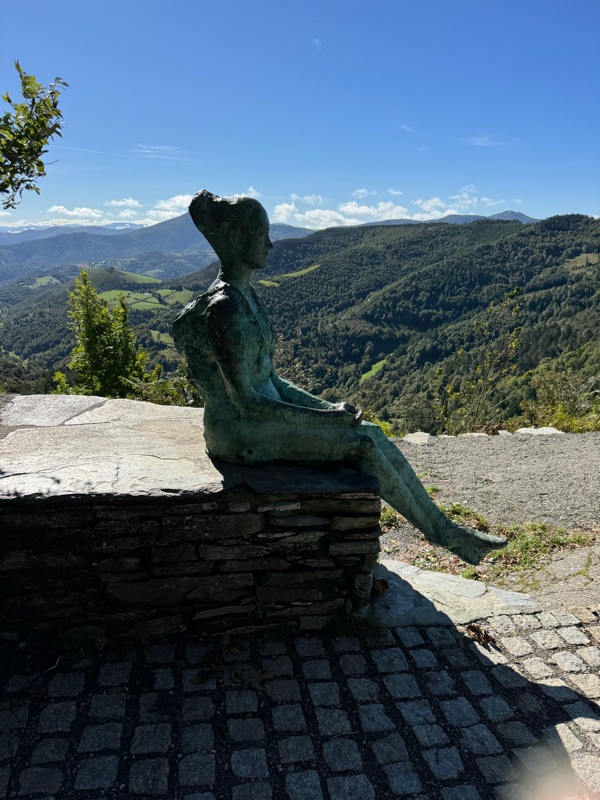
While everyone’s Camino experience is unique to them, here are my answers to many of the questions people asked me about walking the Camino de Santiago. If you have additional questions, feel free to ask away.
The Basics
What motivated this particular destination?
I am not sure I remember the answer to that question. I know that I watched the movie The Way a few years back. That is such a cliché way to be introduced to the Camino de Santiago, but there you have it. I think I was attracted because I like the idea of spending time in a country away from the touristy areas. I like the idea of walking through the countryside and the villages. I also like the idea of a pilgrimage. For me, this was not merely or even primarily an athletic endeavor. It was also an opportunity to reflect and transform. I am not Catholic, and I really don’t care where the bones of Saint James are buried, but the idea of a spiritual and physical pilgrimage is attractive to me. Besides...Spain!
Had you waited a long time for this adventure?
Yes. I’ve wanted to do this for probably 10 years but always thought it was a pipe dream - too expensive, too much time away. Brad, Kathryn (my bonus mom), and Alec kept prodding, though. A year before I left for Spain, I started thinking more seriously about the possibility of walking the Camino when Kristina went to college. One of my running buddies said she’d go, so in January I decided to take the plunge. She ended up not being able to go, but by then I was committed. I'm so glad I did it!
Were you alone or did you go with a companion?
I walked alone. Or at least I went to Spain alone, and I often walked by myself. You are never or rarely completely alone on the Camino. The Way does not run through wilderness, for the most part, and there are hundreds of thousands of people who walk this every year. However, I think the Camino is best experienced on your own. People who come in groups miss some of what the Camino has to offer in terms of individual reflection and also in terms of becoming part of a new community.
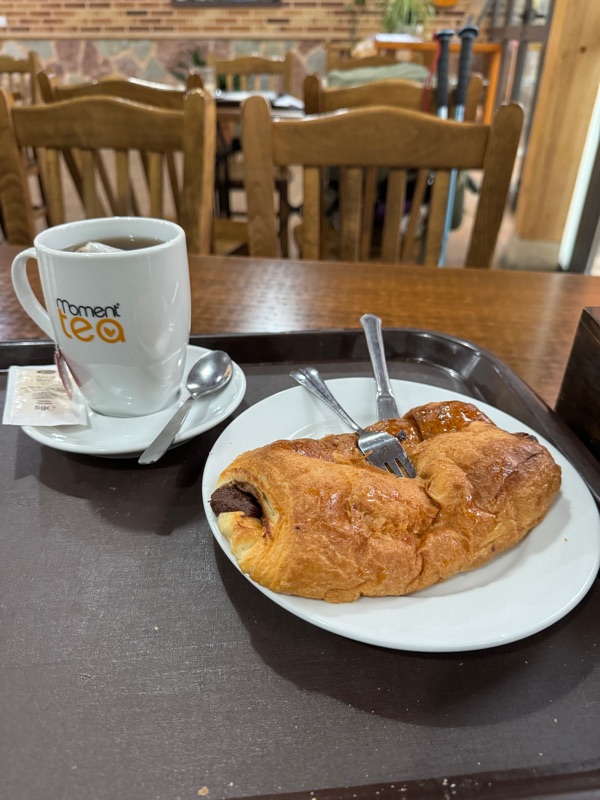
Logistics and Gear
How did you get to St. Jean Pied de Port (the starting point)
I flew from Portland, Oregon to Paris, France (CDG airport). From Paris, I took a regional Air France flight to Biarritz, France. Outside the Biarritz airport, I caught a city bus to Bayonne (next town over), where I stayed the night at a hotel right next to the train station. In the morning, I caught the train from Bayonne to St. Jean Pied de Port.
How did you get back home at the end?
I took a train from Santiago to Madrid, then a plane from Madrid to Seattle (via Dublin).
What did you eat?
I feel like I spent much of my days looking for food or thinking about food. I generally had herb tea and something like a croissant for first breakfast before starting out for the day. Then, a couple of hours later, I would have fresh orange juice and another croissant or cake or tortilla - which is essentially a Spanish omelet with potatoes and sometimes meat or vegetables.
Lunch can be difficult to come by on the Camino, as Spaniards don’t seem to eat lunch in the way that we Americans do. If I was lucky, I was able to find a café that would serve a sandwich. If I was not lucky, I ended up just snacking for the afternoon.
For dinner, we typically had a three course pilgrim meal. This generally consisted of a first course of either soup or salad, followed by a second course of protein (often chicken or fish, sometimes beef), followed by dessert.
I also sampled the nonalcoholic beers (“cervesa 0.0”) in Spain, which are plentiful and much better than I was used to in the States (though we are getting some good options here at home now, as well).
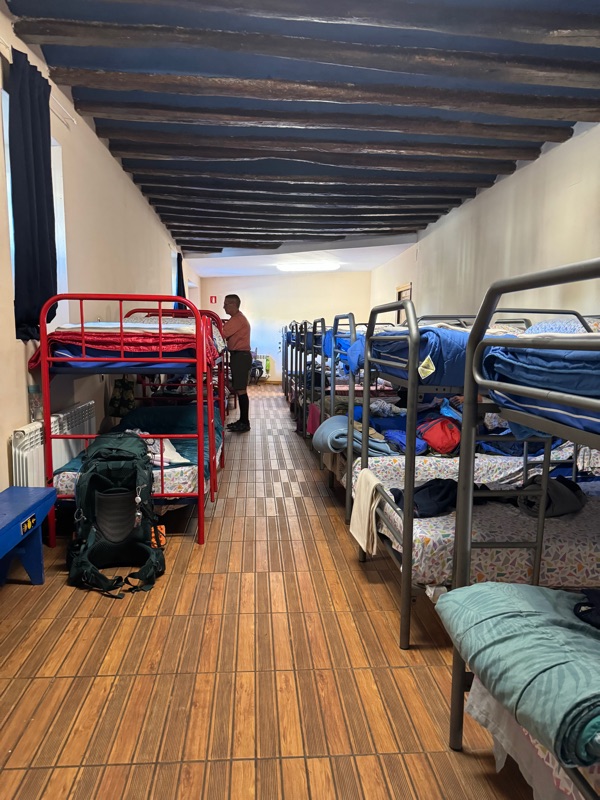
Where did you sleep?
I slept in albergues. These are hostels, generally with rooms filled with bunkbeds. There will typically be a communal bathroom with small shower stalls, and often a gathering space. In general, men and women sleep in the same rooms and often share the same bathrooms. Sometimes, though rarely, sleeping areas are split between men and women. However, everyone was very respectful.
A sleeping room might accommodate just a handful of people, a couple of dozen people, or even up to 100 people, typically in bunk beds. Consequently, earplugs and eyeshades are a must.
Albergues are not the only option. You can pay a little more for a private room or for a room shared with just one other person. Or you can pay substantially more for a hotel. Most people do that once in a while for a break. I only got a hotel once, and that was because I couldn't find an albergue with available beds. In general, I found that the communal living really contributed to the kind of experience I wanted to have on the Camino. I met so many people that I would run into over and over again. It also felt more like a pilgrimage that way, rather than a vacation.
Did your clothing choices serve you well?
Yes! Merino wool, of course, is fabulous for shirts (one short sleeve, one long sleeve), socks, and underwear. My Toura Kaia sports bras worked well (a bit spendy, but worth it). Hokas were good, with my usual combination of toe socks and hiking socks. Puffy (but compact) REI jacket and light gloves with the headband/neck wrap thing were perfect. I got a stiffer brimmed hiking hat specifically for Camino, which I used a lot. Rain poncho was a little warm but worked great. It had actual sleeves and was made to fit over a backpack and still reach down past my knees.
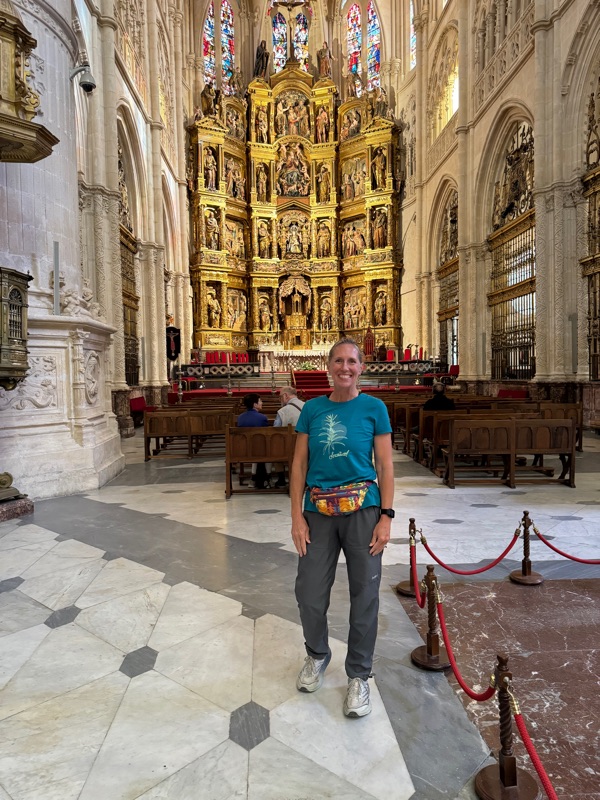
I’m a little on the fence about the rip skirt with Merino wool leggings combination (my evening clothes). It worked ok, and it was nice to have something a little cute to wear. But the evenings in September/October get cool, so I generally had to wear the leggings with the skirt, and the leggings got baggy in the knees. If I were to change anything, I’d probably switch out for Lycra leggings instead of wool.
The only clothing items I bought on the Camino were a cheap, extra long sleeves hurt and a pair of compression socks.
Did you make reservations for your sleeping accommodations?
I didn’t at first, beyond the first night at Orisson (which is a very popular albergue and requires booking weeks or months in advance). But fairly soon I started reserving a day or two in advance. By the time I was halfway through, I got sick of feeling stressed about finding a place, so I booked 3-4 days out. As the way continued to get busier (about 10 days from the end), I finally booked through to Santiago.
How about communications back home?
WhatsApp, Messenger, and Marco Polo worked well. Personally, I preferred messaging to Marco Polos, because I could message no matter who was nearby, but I had family members that preferred polos, and that worked ok. I finally had to ask folks to keep their polos short so that I didn't end up spending much of my walking time (and my data) doing video messages. I also talked with Brad for a couple of hours every day when he was going to sleep and I was starting my walk. I general talked with Kristina on the phone every day and the boys now and again, as well.
How did your family monitor your progress so they knew you were safe?
I talked with Brad several times a day, and I messaged him periodically while I walked (which was in the middle of the night for him, due to the 9-hour time difference). Because I used an eSIM for Europe, I couldn't use the iPhone location sharing, and I’m not wild about the Life 360 app. So Brad did worry a bit for a while. I made it a point to message him every couple of hours.
How much did it cost?
In general, the Camino is a rather affordable way to spend a few weeks in Spain, particularly if you stay in albergues rather than hotels. The food is also generally quite reasonable. Here are my costs, from 2024. Keep in mind that I used frequent flyer miles for my overseas flights, and the euro was roughly equal to the dollar.
Total cost (not including gear) was $2764. This includes rooms, food, all daily expenses, cash, airfare from Paris to Biarritz, and the train from Santiago to Madrid at the end.
During the 30 days I spent on the Camino and the extra day I spent in Santiago, I spent $86/day (or $73/day in daily expenses, plus $435 in airfare and train).
I also spent several hundred on gear, but it’s all stuff I can use for backpacking, etc.
What My Camino Looked Like
Is the trail difficult?
Somewhat to my surprise, parts of the trail are difficult. It’s easy to think that because many people who are older and not in great shape walk the Camino, that the path must be pretty easy. But there are many kinds of terrain to walk on, as well as mountains to climb over, weather to navigate, and long long days on your feet. After a week or two, most pilgrims are limping around, and many have issues with their legs, with blisters, and with other ailments. Walking every day for 6 to 8 hourstakes a toll.
That said, I walked the Camino in 30 days and took 0 rest days, and that didn't feel like a huge stretch. Many people take 40, 50, or even 60 days to walk the Camino, and most take days here and there to rest, recuperate, and sight see. I liked the rhythm of walking all day, though I did have a couple of days that were short (5-10 miles), versus my usual 15-20 miles a day. Short walk days allowed me time to tour the bigger cities like Pamplona, Burgos, and Leon.
Did you have a daily routine or try for something different daily?
I definitely had a routine. Wake up about 6am. Get dressed and packed up, staying as quiet as possible until 7am when any self respecting pilgrim should be up and about. On the path between 7 and 8, ideally with a first breakfast on my way out of town. Talk with Brad on the phone for the first 5-6 miles, then grab a second breakfast. Walk until 2ish (4 on a heavy mileage day). Check into my albergue, shower, wash whatever clothes need washing. Blog or talk to folks until 6 or 7. Grab dinner, get my backpack as ready as possible for the morning, talk with Brad and maybe Kristina and go to bed around 9. Repeat every day, occasionally adding in a little sightseeing.
In general, people go to bed by 9 PM. A group of early risers will get up around 5 AM, but most people get up between 6 and 6:30 AM. Before 6:30 or 7, you try to be very quiet in the dorms. After that, it is sleep at your own risk.
Most people start arriving at their albergue around 1 or 2 in the afternoon. If you get to the Albergue later than 4 PM, you will probably be sleeping in a top bunk.
How far did you walk?
Officially, I walked 484 miles. In reality, it was upwards of 500, as I took a couple of alternate routes, walked around the cities, etc.
Do the miles go by quickly or slowly?
Overall, pretty quickly. Often, I’d get to my albergue by around 2pm, almost always by 4pm. In the morning, or when I was talking with someone, the miles went by quickly. The last 5 miles of the day were often tough, though, and my pace was definitely slower in the afternoons. Some days on the meseta (the long, flat stretch between Burgos and Leon) or when I was hungry or in the rain, the miles seemed to take forever.
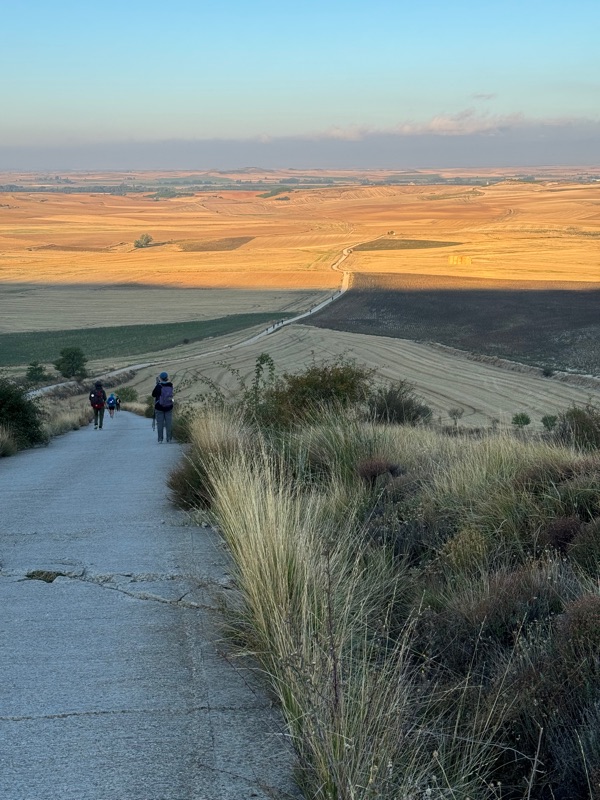
Did you get enough to eat?
Generally, yes. But you need a lot of fuel to walk 15-20 miles a day. And it can be difficult to find real food between 11am and 7pm. Snack options usually involve chips, cake, or chocolate. Sometimes towns are far apart. And when you can find food midday, it’s typically tortillas (which in Spain is basically an egg dish with potatoes) or empanada and not usually very good. On lucky days, I’d find a sandwich. Also, despite all of the gardens I walked past, I did not find a lot of vegetables.
Do you walk with other pilgrims much?
I walked solo more than with other people, but I did spend time walking with other pilgrims periodically. If you walk with someone, the trick is to find someone who walks at your pace and has similar needs for solitude vs conversation. That can be challenging.
Are the paths well marked? How do you find your way?
That is a great question, as it’s something I pondered a lot during my Camino. Generally, the path is pretty well marked with yellow arrows, scallop shells (the Camino icon), blue and yellow Camino signs, and (in Galicia especially) stone markers. However, sometimes, especially in cities, markers would be few and far between or hard to find. When that happened, I depended on the GPS maps included with a couple of the Camino pilgrim apps. And several times lovely local Spanish people would very kindly call out to me and point me in the right direction. Lots of applications to real life here.
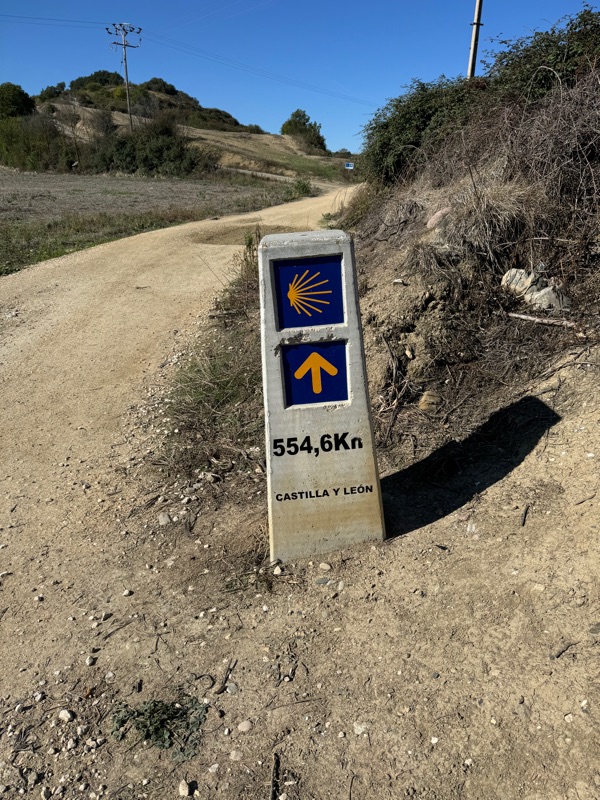
How was the path?
Varied terrain, everything from dirt or rock path through the woods to gravel road, to path next to a busy highway, sidewalks through cities, dusty roads, and more.
Who decides who gets bottom bunk or top bunk?
Generally, it's first come, first serve. Some albergue hosts prefer to save bottom bunks for older people. I told them that I'm almost 60 and count as older.
Why were towels a luxury?
Pilgrims bring their own towels, but because they are trying to save on space and weight, they generally bring small towels. I had a smallish, microfiber towel. It worked, but it wasn't plush by any means. So real towels were a luxury.
What else was a luxury?
Cotton sheets, single beds (as opposed to bunk beds), a room to myself or just sharing with one other person, laundry service, a good breakfast at the albergue.
Was there toilet paper, or did you have to provide your own?
There was toilet paper almost everywhere. I brought my own but only had to use it once or twice. I never had to pee outside, thankfully.
How far did you walk before second breakfast?
Usually about 6 miles. I'd have 1st breakfast around 7ambefore leaving, and then I'd stop around 9 or 10am for second breakfast.
Did you ever feel unsafe, especially in the albergues?
I never felt unsafe in the albergues. And I only got nervous twice that I remember while walking. Once was when I started out alone, long before sunrise. I was walking country lanes in the dark, with only my flashlight to show the way. The path went along a river and under an overpass. A little sketchy, to be sure, but I was fine.
Another time, I made the mistake of jaywalking just as a car came around a corner. The driver (a young guy, probably in his 20s) got really ticked off, flipping me off and yelling as he drove around the corner. I blew him a kiss, figuring it would be less offensive than flipping him off in return. In retrospect, that was a really bad move. He pulled over, jumped out of his car, and charged at me, all the while yelling something in Spanish about calling the police. His friend was also out of the car and filming the whole thing. I just kept saying, "No entiendo. Lo siento." (I don't understand. I'm sorry.) He finally drove off.
How has the Camino affected your relationship with technology, with politics?
Technology really helped my Camino, from train tickets, to communication, to finding my way, booking my stays, blogging, and so forth. In that way, this experience is so different from backpacking in the wilderness.
As for politics, I didn't read or watch the news while on the Camino, which was fabulous during the contentious election. But I was also been surprised to learn just how much Europeans and the rest of the world are invested in American politics. What happens in the US really does affect them.
Physical
How did your body hold up?
My body held up well overall. For several days between about day 4 and day 10, I dealt with some leg pain (vasculitis, or "hikers leg") that is really common on the Camino. I had to learn to take breaks, elevate my legs, do some massage, and get the blood circulating better. I finally bought a pair of compression socks that I wore for a few days.
A few days after the hikers leg cleared up, I got a couple of blisters. But Compeed and Band-Aids did their job. The last couple of weeks I honestly felt great.
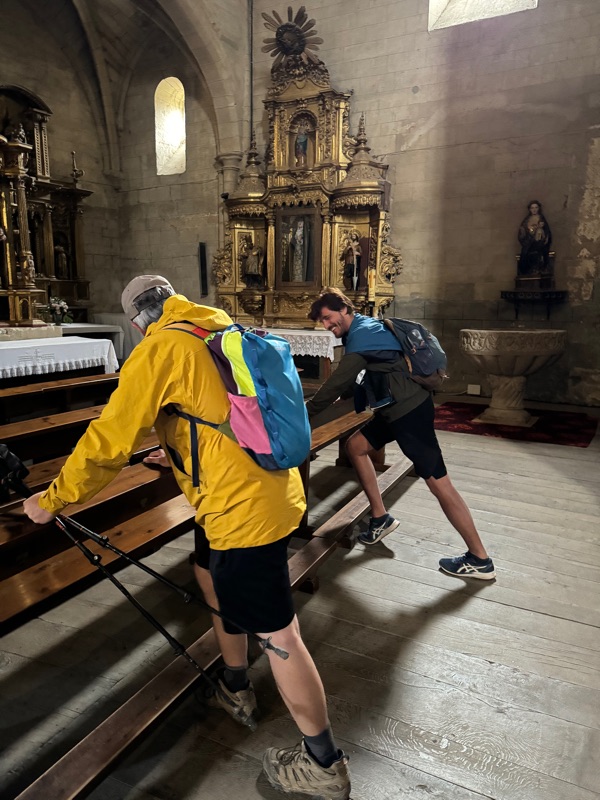
How long does it take to get your Camino legs?
They say 10 days, and that seems about right.The leg pain didn’t kick in until day 3 or 4. The legs were pretty sore for 5-6 days.
How has your body changed? Have you lost weight or become more muscular?
I didn't weigh myself, but I'm pretty sure I lost probably 4-5 pounds while walking. My legs felt more muscular. I spent a week in Madrid with Brad after I finished the Camino, so by the time I got home, I had put a couple of pounds back on, and the rest came back on once I got home. :)
How did sleeping go?
Surprisingly well, particularly considering that I deal with insomnia! I only used sleep meds for the first couple of nights to get through jet lag. I went to bed around 9 every night and work up between 5 and 6. Earplugs and my eyeshade worked great, even when sleeping in a dorm full of people.
The Head Game
What were you hoping to gain?
For me, 2024 was a transition year in many ways. My last child left home the week before I went to Spain. I also reached menopause in the spring and am entering into a new stage of my life as a woman. In addition, this is the first time since I met Brad that we will have a life with just the two of us, without kids in the house. Admittedly, it is a little odd to begin empty nesting by spending five weeks apart. Also, my father passed away in 2024, two years after my mother. And my bonus father passed away just weeks prior. I hoped for this Camino experience to provide me with a reset. I wanted to take a break from everything I had grown accustomed to in life. So I surrounded myself with new scenery, new people, new languages, new rhythms and habits, new food, everything. My hope was that the Camino experience would give me a chance to clean house so that I wouldn't begin this new stage of my life with all of my old habits and scripts intact.
What have you actually gained?
First, surprisingly, this Camino experience has been transformational for my relationship with my husband. We talked every day for a couple of hours, and our conversations had more substance in a positive way than they have in years. This became a Camino for him, as well as for me, and for us as a couple. We have been able to reconnect and begin to build in ways I had not expected.
Secondly, I am rediscovering the adventurous part of myself and beginning to open my mind to possibilities again. For instance, it was empowering to find my way through this part of Europe and realize that traveling abroad does not have to be scary. It brings the world into my radar. I feel very empowered and much more myself than I have felt in decades.
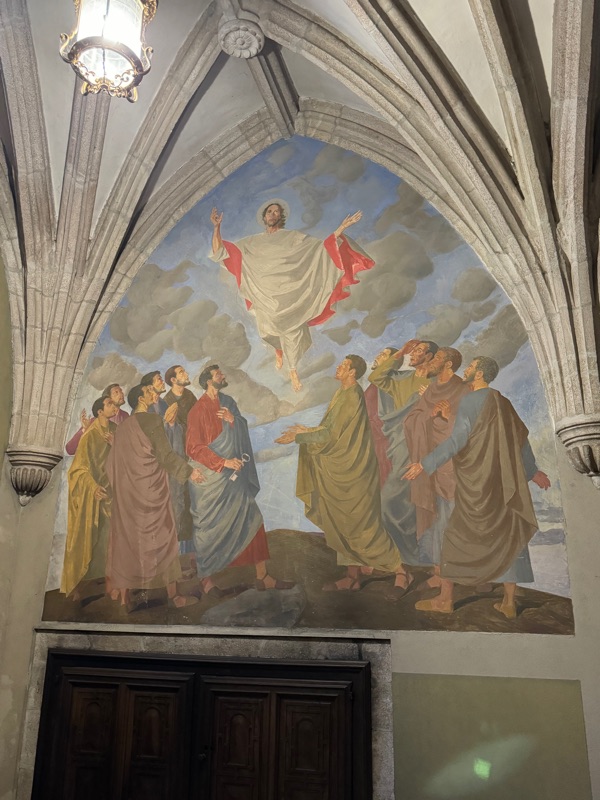
There has also been a spiritual component to the pilgrimage. As I walk, I remember that Jesus spent much of His adult life walking all over Palestine. I know that he can empathize with everything I feel. However, walking all day every day is something I know that he has done before and is so familiar with. It does make me feel closer to Jesus. Also, because so much of the scenery along this path is Catholic, it includes many representations of Jesus Christ, not only of His death, but throughout His life. Seeing and pondering on these representations has also helped me to focus on my Savior.
Is the solitude tedious or helpful?
Both! I like a fair amount of solitude. It allows me to ponder and to soak up the nature around me. I also sometimes like having a break from people. However, on long days when it was hot or my feet hurt or I was hungry, the solitude could be difficult. At those times, it was wonderful to have a walking companion, to get a call from Brad, or simply listen to music or an audiobook.
With hiking time and many fewer distractions, have you felt the Spirit more?
I think so. I was able to still my mind and be in the present more readily while walking. With the stresses of work and worries about other people and other things off in the distance, it left me more open to listen. I had some wonderful talks with God and with my parents while I walked, and it definitely gave me time to ponder.
To top it off, pilgrim conversations often move into spiritual/philosophical realms, which allowed me to talk through things I was pondering along the way.
What things have you realized aren't important to you as a result, and conversely what things do you appreciate more?
Hmmm…in the short term, I realized that appearance really wasn’t important. I wore the same clothes every day for a month, no makeup, hair in a pony tail. I showered and I washed my clothes as well as I could, but I let those worries go. And it was ok! Of course, the day after I arrived in Santiago, I bought clothes and a little makeup, so clearly this was a temporary thing. :)
Long term, I’ve realized how important my relationship with Brad is to me. And I’m realizing how unimportant my worries are, that I can trust God and that all things will actually work together for my good. This one will require continued work.
What did you miss from home?
Brad! Also, having my own shower and fully clean clothes.
What do your priorities look like moving forward?
I want to prioritize Brad and our relationship, instead of trying to fit our relationship around everything else.
I want to be able to live more in the present, focusing on what is before me and what I can control rather than worrying about things that may not even happen or things I cannot control.
I want to keep this adventurous spirit going. It feels more like my genuine self, and I love it. I need to be more ready to say Yes than to say No, more willing to trust that things will work out.
I want to continue to interact with people from all different backgrounds, cultures, and walks of life. This involves considering other perspectives. For instance, I walked for a while with a pastor from the Community of Christ in Poland. He talked about different meditations he practices. One involves always taking a minute to think, "What if I'm wrong?"
Random Spain Notes
Were the pastries sweet?
Yes. But the pastries were definitely better in France than in Spain.
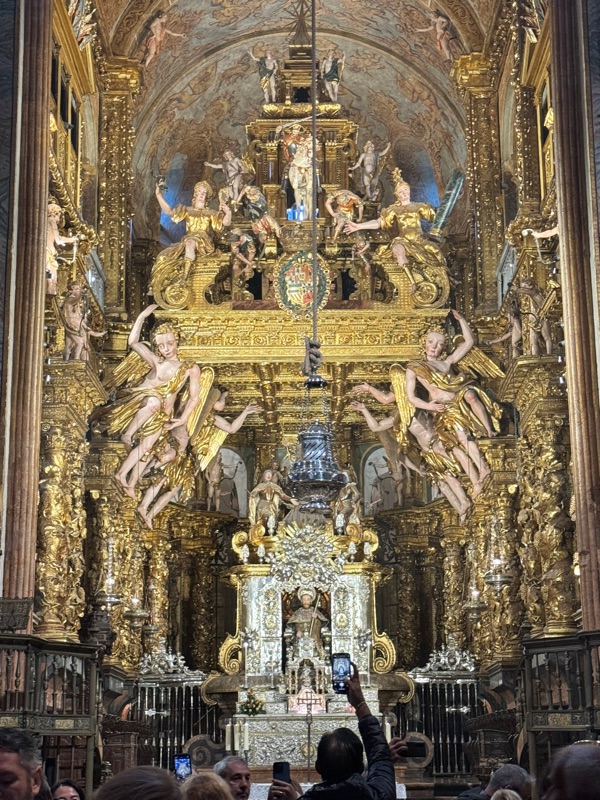
Do regular people use the cathedrals for worship?
Depends a little bit on the cathedral. I went to mass in the Leon Cathedral, for instance, but it was in a smaller chapel rather than the main sanctuary. In Santiago, and in the basilica in Leon, on the other hand, I attended mass in the main sanctuary.
Comments